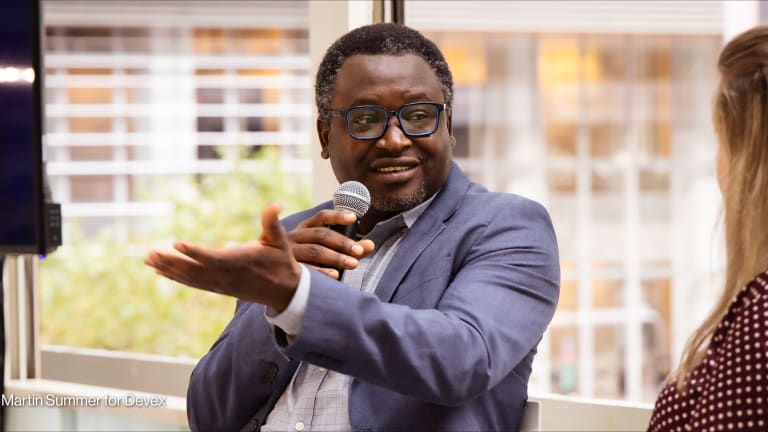
Grassroots leaders around the world have played an important role in responding to the COVID-19 pandemic, due in large part to the trust they have built among the people they serve.
“Trust is embedded in the definition of who we are as community leaders. We look like, we sound like, we live like the people we serve. We are the experts in the needs, the barriers, the assets our communities bring to bear,” said Denise Octavia Smith, the executive director and founder at the National Association of Community Health Workers, which works with community health workers in the United States.
Smith is one of the voices featured in a new report from the Communities First Global Collaborative, a program launched by the Aspen Institute to amplify the work of community leaders globally. Trust has been key to the success of community-based organizations, or CBOs, in reaching vulnerable populations with information regarding COVID-19, according to grassroots leaders in the report.
But despite the impact they have had over the past 18 months, by and large these community leaders and organizations have been excluded from decision-making at the national and international levels.
The report cites research on the lack of community engagement — including perspectives on the non-COVID-19 health and socioeconomic impacts of pandemic response measures — at the national level. It underlines the value of a formal networking system bringing community leaders together as peers, while also calling for more training, support, and resources for these groups.
COVID-19 has led many grassroots leaders and CBOs to expand beyond their normal scope of work, taking on new challenges such as dealing with misinformation.
This nonprofit is helping communities stop pandemics in their tracks
COVID-19 has led to growing recognition of the work that Ending Pandemics, a San Francisco-based nonprofit, is doing to change how countries detect and respond to disease outbreaks.
For example, Shining Hope for Communities, an organization that typically offers services to urban slum dwellers across three cities in Kenya, has expanded its focus from providing education and leadership training for girls and women to activities such as assembling hand-washing stations, raising awareness about COVID-19 prevention, and distributing personal protective equipment.
As many CBOs pivot to address these new efforts, their work often goes undocumented, unrecognized, and uncompensated, the report says.
The COVID-19 pandemic is not the first time CBOs have demonstrated their value in preparing for and responding to disease outbreaks. For example, during the 2014-2016 Ebola crisis in Guinea, Sierra Leone, and Liberia, community leadership was associated with better outcomes, from improved communication around the virus to increased case referrals.
But the past 18 months have served as a wake-up call for the need to ensure that CBOs are involved, particularly in reaching historically marginalized communities.
“For the first time, this notion of health inequities is so profoundly real for us. Before, it was such a theoretical construct. Now we really understand the barriers,” said Peggy Clark, vice president of policy programs and executive director of the Aspen Global Innovators Group at the Aspen Institute.
“It’s not possible to address a pandemic in the ‘last mile’ and hardest-to-serve communities unless you’re working with a trusted community-based organization.”
— Peggy Clark, executive director, Aspen Global Innovators GroupThe report is part of a larger conversation on how lessons from COVID-19 can inform work to prevent or prepare for future pandemics.
One high-profile example is The Independent Panel for Pandemic Preparedness and Response — co-chaired by Ellen Johnson Sirleaf, former president of Liberia, and Helen Clark, former prime minister of New Zealand — which notes that “Community responses and local engagement have been vital resources in the response.
“Where community structures, such as cadres of community health workers, have been mobilized, they have made a critical difference in establishing trust in government instructions, extending services, and in relaying scientific information. However, the potential for communities to shape the response at the decision-making table has been severely neglected.”
The COVID-19 pandemic has highlighted the need for national governments and health system leaders to engage with grassroots leaders and CBOs, but few have incorporated such bottom-up approaches into their planning, according to the report, which cites a relevant study in the journal BMJ Global Health.
The Self Employed Women’s Association, which promotes the rights of low-income and independently employed female workers in India, has focused on protecting its members from the health and economic impacts of COVID-19. SEWA members have sewn masks, organized PPE kits, and packaged dry snacks for people in lockdown.
When SEWA’s community leaders began to wear these masks and distribute them in the Indian villages where they are based, proper usage increased from 23% to 62%, said Reema Nanavaty, who leads the organization, adding that community leaders are now being mobilized to address vaccine hesitancy.
National Institution for Transforming India, a government think tank also known as NITI Aayog, asked Indian states to set up COVID-19 task forces involving CBOs such as SEWA, she said. SEWA has worked in partnership with three state governments.
Each of these CBOs brings different strengths to the table, but they are all committed to ensuring that government relief reaches the poorest of the poor, Nanavaty said.
While she isn’t necessarily confident that the government will remain committed to working with CBOs, Nanavaty said she doesn’t think this will stop them from delivering.
“As far as our country is concerned, I don’t think things are going to change,” she said. “Only when the incidences blow out of proportion, and it becomes inevitable — then the government will start involving community leaders in the task force. But in countries like ours, there’s such a spirit of volunteerism, so the community leaders don’t wait for the government’s invitation. They start acting on their own once they see how their fellow citizens are suffering.”
But Clark of the Aspen Global Innovators Group said governments cannot respond to this pandemic, nor prepare for future pandemics, without engaging CBOs.
“Community-based organizations and leadership in the most marginalized communities need to be part of the national response in order to address these inequities,” she said. “It’s not possible to address a pandemic in the ‘last mile’ and hardest-to-serve communities unless you’re working with a trusted community-based organization. If you don’t enlist community-based organizations, you will not address these disparities in testing or vaccination or treatment.”
This coverage, presented by the Bay Area Global Health Alliance, explores the intersection between technology, innovation, and health. How are tech, innovation, and cross-sector partnerships being leveraged to accelerate equitable access to health care?









